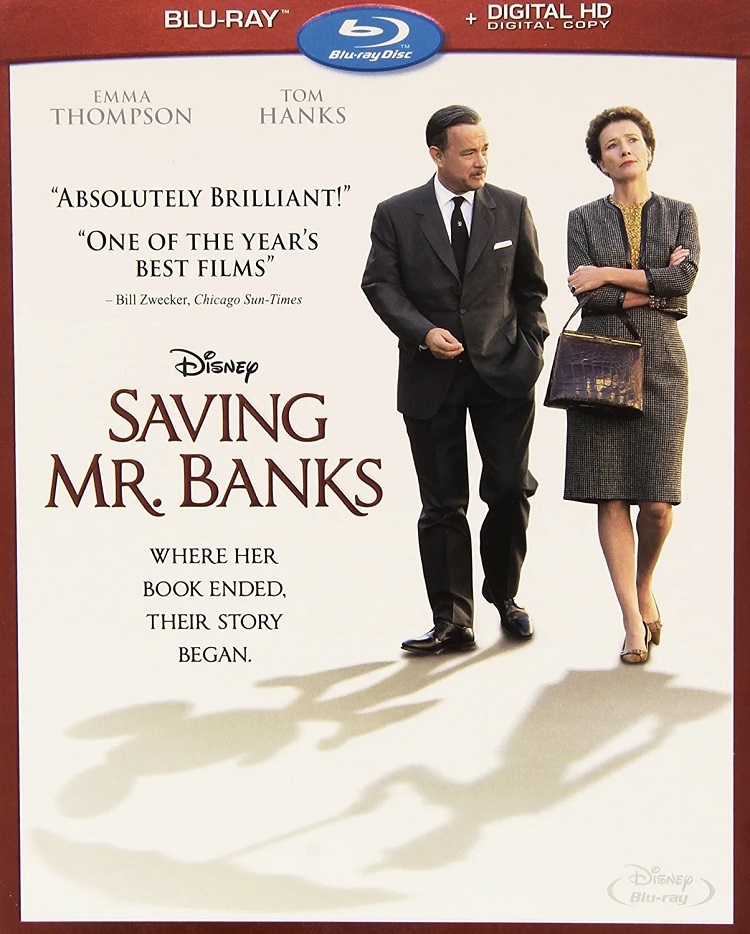
It is rare that I am interested in watching a movie a second time after a recent viewing. It is usually a few years before I am ready. Saving Mr. Banks is a rare exception to this rule because I was actually excited to see it again, and it proved to be even more delightful.
Walt Disney (Tom Hanks) is determined to fulfill a 20-year promise to his daughters by bringing their beloved character, Mary Poppins, to life. Author P. L. Travers (Emma Thompson) has fought him all along but due to financial difficulties she is convinced to travel from her home in London to Los Angeles to discuss finally relinquishing the film rights. In an attempt to win her over, Walt introduces her to his production team of screenwriter Don DaGradi (Bradley Whitford) and music composers Richard and Robert Sherman (Jason Schwartzman and B. J. Novak) along with giving her script approval.
While collaborating on the development of the script, Travers flashes back on her difficult childhood. Her father, Travers Goff (Colin Farrell), is a charismatic, alcoholic bank manager who is completely enamored by his daughter and vice versa. It becomes clear that the love of her father and witnessing his downward spiral is the cause for her desire to completely control all aspects of the film and her unwillingness to let go of the characters who have become her family.
Her only haven from the trauma of reliving her past and the destruction of her characters is with her driver Ralph (Paul Giamatti). Her inability to separate from her issues of the past makes the creative process harder and harder, resulting in huge doubts that she will ever agree to sign over the rights.
Although we know Mary Poppins was eventually made by Disney, real tension is created regarding how he is going to be able to convince her. The resolution is satisfying and provides insights into Disney as well as Travers.
Emma Thompson is a perfect balance of harshness and vulnerability. She is the solid foundation which makes the movie the success that it is. While displaying how truly difficult P. L. Travers must have been during the creative process, she is also able to create a connection with the audience. You care for her and feel for the difficult childhood she experienced, which lead to the creation of her beloved character and her desire to protect her in every way she could.
In regards to the rest of the cast. Jason Schwartzman is a huge surprise. As Richard Sherman, he is simply charming and lights up the screen whenever he is on. He even plays the piano during the film. I had no idea Farrell was even in the film until it started. This is one of his best performances as a flawed man who adores his daughter who manages to garner unconditional love from her in return. Hanks, Giamatti, and Novak are also solid in their supporting parts by helping to create a believable setting for an interesting story that deserves to be told even if not 100% accurate.
The Blu-ray has been given 1080p/MPEG-4 AVC encoded transfer displayed at an aspect ratio: 2.39:1. The image is colorful and looks free of digital artifacts. The audio is available as a DTS-HD Master Audio 5.1 surround track. Dialogue is clear and the ambiance in the rears is best created during a trip to Disneyland. The Blu-ray comes with a Digital HD copy.
Disappointingly, there are very few extras included on the Blu-ray edition. “The Walt Disney Studios: From Poppins to the Present” follows director John Lee Hancock on a tour of the Disney Studios lot providing history and studio life at the time of the making of Mary Poppins, along with an interview with Richard Sherman. It is interesting but at 14 minutes is too short to get any in-depth information. “Let’s Go Fly a Kite” is a touching tribute to Richard Sherman on the last day of filming. There are also deleted scenes which actually add to the film. I was wishing for commentary on why they were cut.
I have read several articles addressing all of the incorrect information in Saving Mr. Banks and I have no issues in enjoying the illusion. Unless I am watching a documentary, I have an expectation that any film based on real life will twist the truth usually for a more happy ending. In this case, the truth-twisting results in a heartwarming story about the making of a classic.